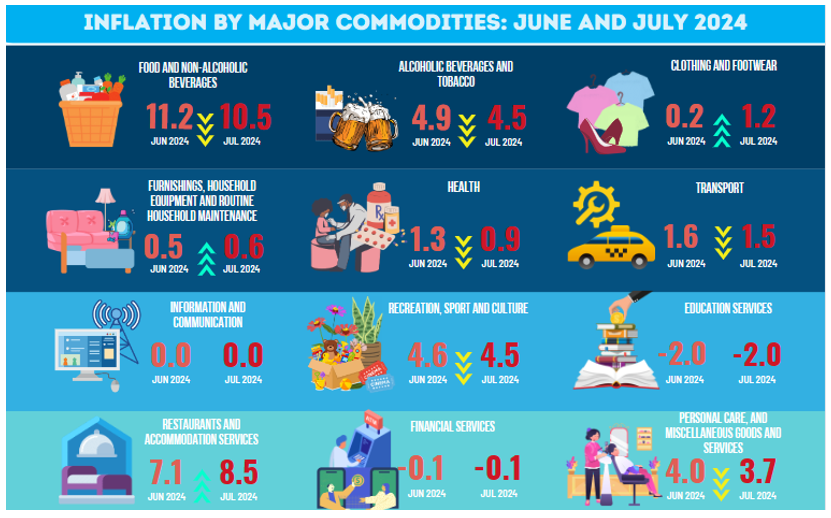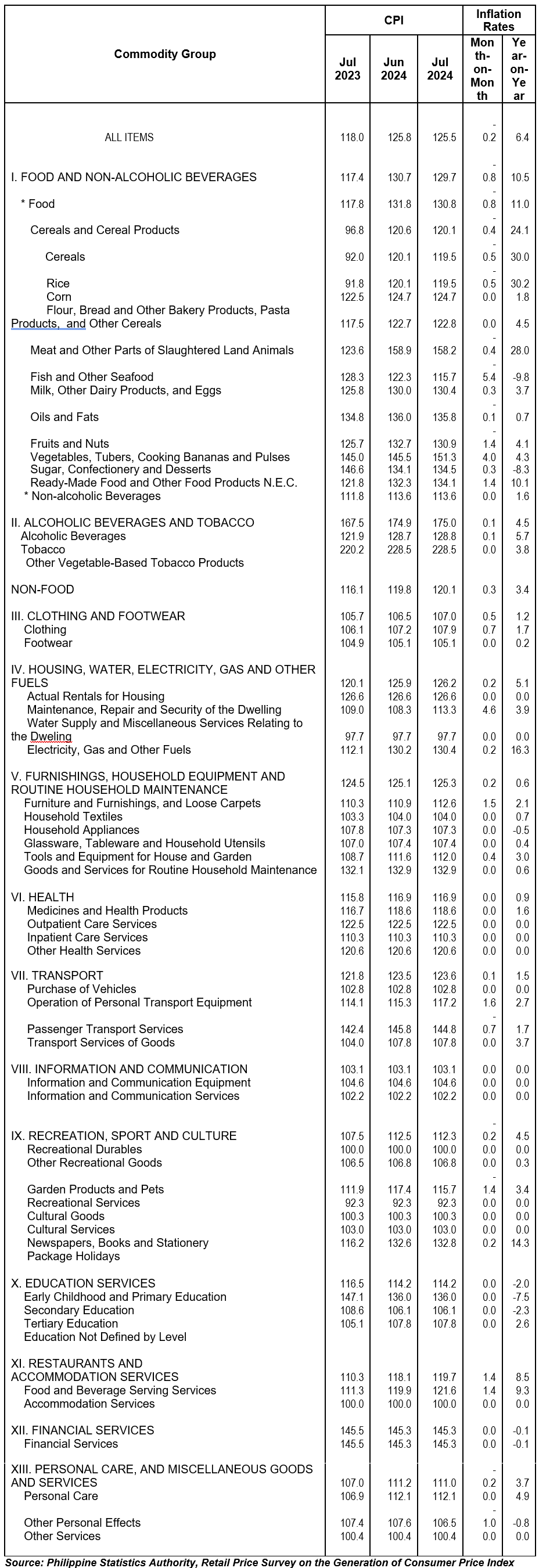Year-on-Year Inflation
In July 2024, the headline inflation in Aklan grew at a faster rate of 6.4 percent compared to the 6.2 percent recorded in the previous month. It also recorded a notable increase of 2.9 percentage points from the 3.5 percent inflation observed in July 2023. Aklan's inflation rate exceeds both the national and regional rates, standing at 4.4 percent and 4.8 percent, respectively.
Table 1. Year-on-Year Inflation Rates, All Items
In percent
(2018=100)


Among the major commodity groups, the primary factor contributing to the uptrend in inflation this month was Housing, water, electricity, gas and other fuels, registering a faster inflation of 5.1 percent from 2.6 percent in the previous month. It was observed that Electricity mainly brought the higher inflation of HWEG and other fuels, showing an increase from 10.1 percent in June 2024 to 21.1 percent inflation in July 2024. Following this, Restaurants and accommodation services that displayed an increase in inflation from 7.1 percent in the previous month to 8.5 percent in July. Clothing and footwear increased from 0.2 percent a month ago to 1.2 percent reported this month, while Furnishings, household equipment and routine household maintenance grew from 0.5 percent in June 2024 to 0.6 percent in July 2024.
Inflation of the rest of the major commodities either decline or remained stable in July 2024 from June 2024.
On the other hand, inflation of Food and non-alcoholic beverage slowed down from 11.2 percent to 10.5 percent in July 2024.
Among the food commodities, Rice contributed the highest to the downtrend in inflation of Food and non-alcoholic beverages, having 35.4 percent inflation in June 2024 to 30.2 percent in July 2024. Fish and other seafoods also had inflation turnaround this month from -4.7 percent to -9.8 percent.
Meanwhile, other food products price increased faster from June to July 2024:
- Fruits and nuts, from -1.8 percent to 4.1 percent;
- Vegetables, tubers, plantains, cooking bananas and pulses, from -0.9 percent to 4.3 percent;
- Sugar, confectionery and desserts, -8.5 percent to -8.3 percent; and
- Ready-made food and other food products n.e.c., from 8.8 percent to 10.1 percent.
Major Contributors to Inflation

The overall inflation of Aklan was mainly contributed by price hike of Food and Non-Alcoholic Beverages which recorded 10.5 percent inflation with 67.7 percent share to overall inflation. This was followed by Housing, water, electricity, gas and other fuels at 5.1 percent inflation with 15.3 percent share to inflation, and Restaurants and accommodation with 8.5 percent inflation and 8.0 percent share to inflation.
Other major commodity groups also contributed to the province’s inflation rate in July 2024:
- Personal care, and miscellaneous goods and services, 3.7 percent inflation with 2.7 percent share;
- Transport, 1.5 percent inflation with 2.2 percent share;
- Alcoholic beverage and tobacco, 4.5 percent inflation with 1.9 percent share; and
- Recreation, sport and culture, 4.5 percent inflation with 1.0 percent share.
Purchasing Power of Peso

The purchasing power of peso (PPP) is inversely associated with inflation, which implies that as inflation increases, the purchasing power of peso decreases.
PPP in July 2024 was valued at 80 centavos, lower than 85 centavos recorded PPP in the same month last year.
This indicates that a 1000-peso worth of goods and services bought in 2018 will require a person an additional P255.00 in order to buy them in July 2024.
Moreover, 10.5 percent inflation in food commodities results in an additional P297.00 this July 2024 in order to buy the same basket of food commodities worth P1000.00 in 2018.
Table 2. Consumer Price Index by Subgroup, Month-on-Month and Year-on-Year Percent Changes
in Aklan
(2018=100)

EXPLANATORY TEXT
Consumer Price Index (CPI) - is an indicator of the change in the average retail prices of a fixed basket of goods and services commonly purchased by the households relative to a base year. It shows how much on the average, prices of goods and services have increased or decreased from a particular reference period.
The CPI Report was derived from the results of the 2018-based CPI survey comprised of thirteen (13) major commodity groups. These are the following: Food and Non-alcoholic Beverages; Alcoholic Beverages and Tobacco; Clothing and Footwear; Housing, Water, Electricity, Gas and Other Fuels; Furnishings, Household Equipment and Routine Maintenance of the House; Health; Transport; Information and Communication Services; Recreation, Sport and Culture; Education; Restaurants and Accommodation Services; Financial Services; and Personal Care and Miscellaneous Goods and Services.
Inflation rate is defined as the annual rate of change or the year-on-year change in the CPI.
Purchasing power of peso is a measure of the real value of the peso in a given period relative to a chosen reference period.
Market basket is a term used to refer to a sample of goods and services that are commonly purchased and bought by an average Filipino household.
Base period or Base Year is the period, usually a year, at which the index number is set to 100. It is the reference point of the index number series. In this report, 2018 is used as the base period.
ENGR. ANTONET B. CATUBUAN
Chief Statistical Specialist

